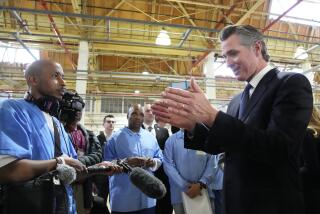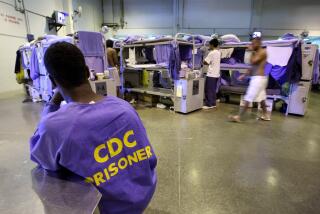Prisons Over Schools: Formula for Failure : State budget: Jailing ever more Californians may jeopardize our future.
- Share via
I’d like to share with you the lives of two of my constituents, both public employees.
One is an elementary school teacher in the San Luis Obispo area. In high school, she was near the top of her class, and she received a bachelor’s degree from UC Santa Barbara. But the 134% increase in student fees during her time at UC forced her to work 20 hours a week, take an extra year to graduate and take out $21,000 in student loans. Now she is in her first-grade classroom from 8 a.m. to 3 p.m. every day, often staying until 5 p.m. before going home to prepare the next day’s lesson plan and grade homework in the evenings.
Her $24,500 starting salary is just enough to get her by with her large student-debt load; she gets no overtime despite many 50- to 60-hour weeks, and she knows that her advancement will depend substantially on whether she pursues a graduate education during summer breaks.
Another of my constituents works at the California Men’s Colony at San Luis Obispo. He is a prison guard. This fellow doesn’t have a college degree; a high school equivalency certificate and a few weeks of training were all he needed to qualify for his job. Many of his colleagues have stronger qualifications, being retired military or police personnel already drawing pensions. With a starting salary of $29,000 and overtime paying him time and a half, he knows he’s lucky. And after two years on the job he has a good chance to be making at least $40,000 a year. It’s a tough job--the threat of violence is always present--but the money and job security are worth the risk.
These two profiles--the new teacher and the new prison guard--illustrate just how far out of whack our state’s priorities have become. We ask some of our most talented high school students to forgo a paycheck for five years, incur substantial debt and work long hours for a modest salary with few benefits, then entrust them with the vital task of educating the next generation. Yet we pay high school dropouts with no student debt and little training 20% more plus overtime to baby-sit murderers, rapists and thieves.
Worse yet, it’s not only the salaries and benefits that are out of whack; it’s the entire state budget. In 1970, the state spent nearly twice as much on the University of California as it did on the youth and adult correctional systems combined. Ten years later, expenditures on the correctional system exploded, raising corrections’ share of the General Fund budget by 1985 to nearly match UC’s; prison costs have continued escalating ever since. The 1994-95 budget just approved by Gov. Pete Wilson gives our correctional system yet another 9% annual increase.
In a quarter of a century, we have effectively reversed our budget priorities: We now spend almost twice as much putting people in jail in California as we do offering our brightest young people a high-quality college education.
Don’t look for this ratio to improve any time in the near future. The “Three Strikes and You’re Out” legislation signed by Wilson--which could put check-forgers in jail for life if they have two prior felonies--promises our correctional system a steady flow of new inmates far into the future and promises an uphill fight for state funds for our education system.
When the history of the 1990s is written, will people look back and shake their heads in disbelief at this era when international economic competition, an explosion of diversity at home and a shrinking middle class threatened our future, and we chose to invest in prisons rather than schools, guards rather than teachers? Teachers and prison guards each perform necessary functions, and both deserve a decent wage. But somewhere in the swirl of frustration and anger surrounding our anti-crime fervor, we have lost track of where we are going and what our destination should be.
More to Read
Get the L.A. Times Politics newsletter
Deeply reported insights into legislation, politics and policy from Sacramento, Washington and beyond. In your inbox twice per week.
You may occasionally receive promotional content from the Los Angeles Times.










